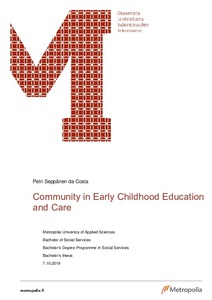Community in Early Childhood Education and Care
Seppänen da Costa, Petri (2019)
Seppänen da Costa, Petri
2019
All rights reserved. This publication is copyrighted. You may download, display and print it for Your own personal use. Commercial use is prohibited.
Julkaisun pysyvä osoite on
https://urn.fi/URN:NBN:fi:amk-2019111120966
https://urn.fi/URN:NBN:fi:amk-2019111120966
Tiivistelmä
The purpose of this Bachelor’s thesis was to explore the topic of community in Early Childhood Education and Care (ECEC), and find out how it can be beneficial for children and how it would be possible to form a community between two ECEC centres and the people in their neighbourhoods.
This study was carried out with the involvement of two ECEC centres located in different neighbourhoods of Helsinki, Finland, in a qualitative method. The groups which participated in this study compromised of 14 children, 4 teachers, and 2 managers from these ECEC centres; and 8 residents from these two neighbourhoods. Data for this study were collected by outside observations of these neighbourhoods and the outside spaces which the children and teachers use regularly, by conducting interviews with the children, by sending an online questionnaire for the teachers and managers, by conducting follow up interviews with the managers and two teachers, and by sending an online questionnaire for residents of these two neighbourhoods.
The results showed that there is an interest and even some ideas from the teachers and managers of these ECEC centres to form a community with its local people, as well as an interest from the children. Furthermore, these ECEC centres use their neighbourhoods already as a learning environment and share spaces with some of the local people, which could be advantageous when pursuing this idea. Lastly, they acknowledged that this idea would present positive outcomes for the children, as it would broaden the children’s mind and give them a sense of community. However, most of the residents would neither be interested in this idea nor would have time to get involved with the ECEC centres. On the other hand, some residents could get involved depending on the activities and the schedule proposed by the ECEC centres.
This demonstrates that it will be up for these ECEC centres, and possibly other ECEC centres as well, to find suitable methods, activities and spaces which could help establish and develop a community with their local people.
This study was carried out with the involvement of two ECEC centres located in different neighbourhoods of Helsinki, Finland, in a qualitative method. The groups which participated in this study compromised of 14 children, 4 teachers, and 2 managers from these ECEC centres; and 8 residents from these two neighbourhoods. Data for this study were collected by outside observations of these neighbourhoods and the outside spaces which the children and teachers use regularly, by conducting interviews with the children, by sending an online questionnaire for the teachers and managers, by conducting follow up interviews with the managers and two teachers, and by sending an online questionnaire for residents of these two neighbourhoods.
The results showed that there is an interest and even some ideas from the teachers and managers of these ECEC centres to form a community with its local people, as well as an interest from the children. Furthermore, these ECEC centres use their neighbourhoods already as a learning environment and share spaces with some of the local people, which could be advantageous when pursuing this idea. Lastly, they acknowledged that this idea would present positive outcomes for the children, as it would broaden the children’s mind and give them a sense of community. However, most of the residents would neither be interested in this idea nor would have time to get involved with the ECEC centres. On the other hand, some residents could get involved depending on the activities and the schedule proposed by the ECEC centres.
This demonstrates that it will be up for these ECEC centres, and possibly other ECEC centres as well, to find suitable methods, activities and spaces which could help establish and develop a community with their local people.
